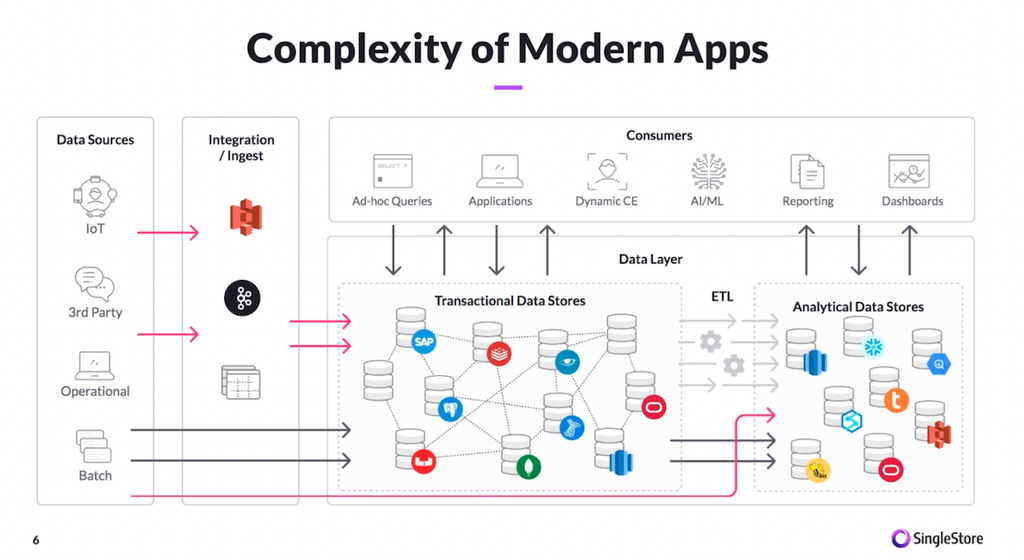
Get to know SingleStoreDB, the fastest-growing distributed SQL database to power real-time applications and analytics.
In today’s data-driven world, two things are certain: Customers want their data, and they want it fast. With a unified data engine for transactional and analytical workloads, SingleStoreDB powers those fast, real-time analytics and applications customers expect. How? SingleStoreDB is built with the key features and capabilities necessary to truly deliver up-to-the-minute insights — no matter the query complexity, size or number of users. It’s where fast, unified and resilient converge to make real time a reality.
But let’s take a step back: What exactly is SingleStoreDB? What makes it unique, and why is it the right database for real-time analytics and applications? Our latest webinar, “Introduction to SingleStoreDB” takes a closer look at these things — and more. Here are the highlights.
A Real-Time Analytics Database for Modern Applications
The challenge
We see modern applications all around us today. “We all are now in the digital service economy,” says Domenic Ravita, VP of Product Marketing & Developer Relations at SingleStore. “We can have anything we want instantaneously…and that’s not just for consumer apps — this is how business is done.”
These applications are prevalent in nearly every industry, from cybersecurity to IoT, fintech, eCommerce and more. To run efficiently, modern apps must also have the ability to:
- Access to real-time data
- Deliver fast, interactive customer experiences
- Scale effortlessly
- Run anywhere, anytime
Yet modern, real-time applications also come with complexities and challenges — something organizations tend to solve for this by constantly adding (or ‘stitching’) various technologies and data stores together. This includes open-source databases like MySQL, PostgreSQL and MongoDB, as well as data warehouses like Snowflake.
The problem? These individual data stores simply aren’t powerful enough to deliver the real-time experiences for your applications, APIs and dashboards. And, constantly adding new technologies to accommodate required functionalities ends up being extremely costly for businesses.

The solution
“What SingleStore provides is a solution and anecdote to these modern application challenges,” says Ravita. “We’re a database built to address these kinds of performance, scale and concurrency challenges.” As a unified, distributed, relational multi-model cloud database designed for real-time applications and analytics, SingleStoreDB solves three core needs:
- Speed. SingleStoreDB delivers low-latency, single-digit millisecond responses on user queries — and has the power for parallel streaming ingestion of millions of events/second.
- Scale. Not only do users see 10-100x performance improvements at ⅓ the cost of legacy databases, but SingleStoreDB also boasts 60% better price-performance and TCO over popular database combinations, like MySQL-Snowflake and PostgreSQL-Redshift.
- Simplicity. SingleStoreDB is multi-model and built to handle various data types (including JSON, time-series, geospatial and full-text search), and runs in multi- or hybrid-cloud environments. And, SingleStoreDB features familiar SQL tooling and is MySQL wire-protocol compatible — simplifying your application architecture.
Live Demo: Real-Time Marketing Analytics With SingleStoreDB
As mentioned earlier, SingleStoreDB’s functionalities serve a wide variety of industries, including adtech, martech, fintech and beyond. To demonstrate exactly how it works, SingleStore Director of Solutions Engineering Sarung Tripathi walks you through how to apply it to a digital marketing example.
In his application, Tripathi demonstrates how you can use SingleStoreDB to serve ads to users based on their buying behaviors, based on the following criteria:
- Location
- Purchase
- Request history
You’ll get an in-depth look at how to connect to SingleStoreDB, setup the schema, ingest data, set-up offers and more — and learn how you can get $600 in free SingleStoreDB credits. Want to run it yourself? You can also check out the code on Github.





